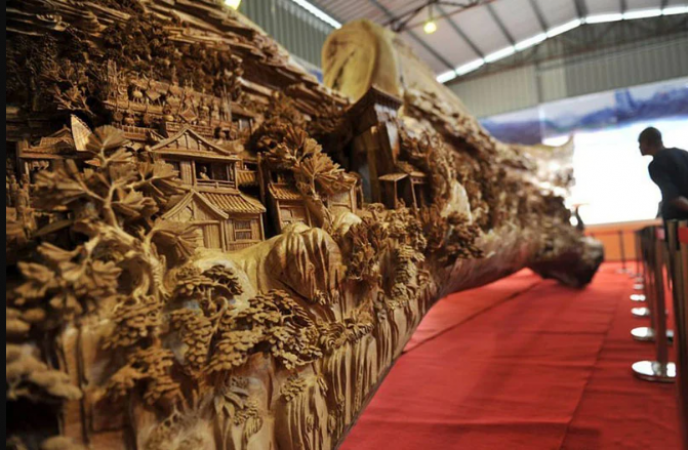
New Delhi: Wood carving is a sculpture technique that involves carving a flat piece of wood to create the illusion of a three-dimensional form. The process begins with the wood carver envisioning a design and matching it to a suitable piece of wood.
The design is then transferred to the wood using tracing paper, and the carver simplifies it into basic shapes. To achieve the desired perspective, depth, and illusion, the carver determines which cuts to make. Various tools and techniques are employed to bring the design to life.
By removing excess wood with a mallet and chisel, the carver gives the simple shapes depth. Gouging, scraping, and burnishing are used to enhance the details of the carved depths. As a result, the three-dimensional form starts to emerge. Sandpaper is used sparingly to remove debris from the background, with the carver relying primarily on the tools to do the work.
Experienced carvers develop a level of comfort in allowing the wood to dictate the carving process. Sometimes, the wood itself may lead to changes in the original design. When mistakes occur, carvers abide by the following principle: "It's only a piece of wood. It becomes a masterpiece only when the carving is complete. If a mistake is made, start afresh with another piece of wood."
Also Read: President Biden: The US will be able to sell F-16s to Turkey
Wood has been a popular material for artists and designers for centuries due to its availability and ease of carving. Its use in art has evolved alongside broader artistic trends. Initially, wood was predominantly employed for votive and religious sculptures, eventually transforming into abstract forms. Wood was once highly polished and colored, but later artists began appreciating its natural qualities and textures, valuing it in its unaltered state.
Beyond its material attributes, wood has been imbued with social and cultural meanings that influenced its usage. In Western art, wood was initially viewed as culturally inferior to materials like marble, but it gained recognition and widespread use among modern and contemporary artists.
The significance of wood carving in art is substantial. Its history dates back to prehistoric times, with wooden objects serving ritual purposes. The oldest known wood sculpture is the Shigir Idol, carved approximately 11,000 years ago. In the Middle Ages, Christianity recognized the value of wood for religious purposes and carved crosses, figures, and saints from it. However, many of these wood sculpture masterpieces deteriorated over time due to the material's susceptibility to water, insects, and fungi.
Today, wood carving and woodworking are highly respected and valued artistic techniques, alongside other forms of art. Despite the negative historical associations surrounding wood's cultural implications, the fascination with wood and its inherent qualities remains strong. Artists continue to carve this versatile material into remarkable art objects, appreciating its unique characteristics.
Wood carving is popular in various countries around the world. While it may be challenging to provide an exhaustive list, here are some countries known for their rich wood carving traditions:
1. Japan: Japan has a long history of wood carving, particularly in the form of traditional sculpture and architectural ornamentation, such as in temples and shrines.
2. China: Chinese wood carving has a diverse range of styles and techniques, often incorporating intricate detailing and symbolism. It has been used for decorative purposes, furniture, and religious sculptures.
3. India: Wood carving has been a prominent art form in India for centuries. Intricately carved wooden panels, furniture, and architectural elements can be found in temples, palaces, and historic buildings.
4. Thailand: Thai wood carving is renowned for its intricate patterns and delicate details. It is commonly seen in Buddhist temples, where it adorns pillars, doorways, and furniture.
5. Indonesia: Wood carving is deeply ingrained in Indonesian culture, with each region having its distinct carving style. Balinese wood carving, for example, is known for its elaborate and expressive figures.

6. Nigeria: In Nigeria, wood carving has a strong cultural significance, with a focus on sculpting masks, statues, and functional objects like furniture and utensils.
7. Mexico: Mexican wood carving, known as "alebrijes," is characterized by vibrant colors and imaginative designs. It often depicts animals and mythical creatures.
8. Switzerland: Switzerland has a rich tradition of wood carving, particularly in the Alpine regions. Intricate woodwork is used in the creation of traditional wooden chalets, furniture, and sculptures.
9. Norway: Norwegian wood carving is closely associated with the country's cultural heritage, particularly in the form of decorative objects like rosemaling (traditional painting) and traditional wooden stave churches.
10. Papua New Guinea: Wood carving holds great significance in the indigenous cultures of Papua New Guinea. Intricate masks, figures, and ceremonial objects are carved using traditional techniques.
These are just a few examples, and wood carving can be found in many other countries as well. The art form has diverse expressions and techniques across different cultures, reflecting their unique artistic traditions and heritage.
Also Read: Japan's goods might be prohibited in Hong Kong if radioactive water is released
wood carving is a timeless art form that has captivated artists and enthusiasts throughout history. From its humble beginnings as a medium for religious sculptures to its evolution into a diverse and revered artistic technique, wood carving continues to thrive in the modern world.
Its ability to transform a simple piece of wood into a three-dimensional masterpiece is a testament to the skill, creativity, and dedication of the carver. Across various countries, from Japan to Mexico, from India to Norway, wood carving traditions have flourished, each with its own distinct style and cultural significance.
As artists embrace the inherent qualities of wood and push the boundaries of their craft, the fascination with this versatile material and the art of wood carving is sure to endure for generations to come.